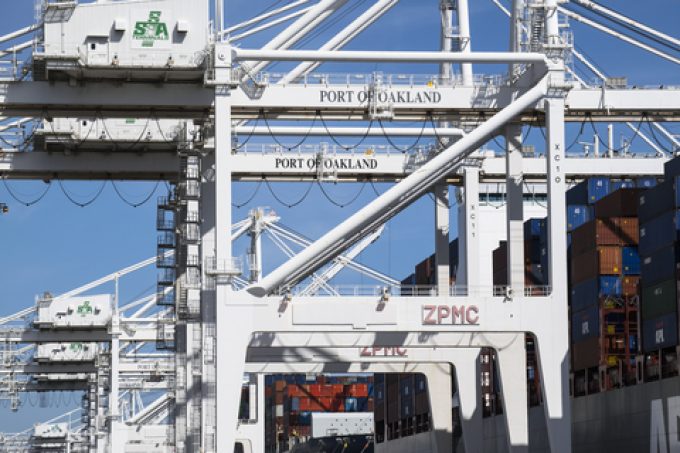Trump will have a 'heavy impact on container volumes', warns Wan Hai chief
US president-elect Donald Trump’s policies will have a heavy impact on container volumes and supply ...
FDX: ABOUT USPS PRIVATISATIONFDX: CCO VIEWFDX: LOWER GUIDANCE FDX: DISRUPTING AIR FREIGHTFDX: FOCUS ON KEY VERTICALFDX: LTL OUTLOOKGXO: NEW LOW LINE: NEW LOW FDX: INDUSTRIAL WOESFDX: HEALTH CHECKFDX: TRADING UPDATEWMT: GREEN WOESFDX: FREIGHT BREAK-UPFDX: WAITING FOR THE SPINHON: BREAK-UP ALLUREDSV: BREACHING SUPPORTVW: BOLT-ON DEALAMZN: TOP PICK
FDX: ABOUT USPS PRIVATISATIONFDX: CCO VIEWFDX: LOWER GUIDANCE FDX: DISRUPTING AIR FREIGHTFDX: FOCUS ON KEY VERTICALFDX: LTL OUTLOOKGXO: NEW LOW LINE: NEW LOW FDX: INDUSTRIAL WOESFDX: HEALTH CHECKFDX: TRADING UPDATEWMT: GREEN WOESFDX: FREIGHT BREAK-UPFDX: WAITING FOR THE SPINHON: BREAK-UP ALLUREDSV: BREACHING SUPPORTVW: BOLT-ON DEALAMZN: TOP PICK

Proposed new import tariffs, by US authorities on Chinese-manufactured ship-to-shore cranes, are set to be delayed for units that were ordered before May.
The US Office of Trade Representative (USTR) confirmed it would press ahead with plans to levy a 25% tariff on Chinese-made container cranes originally scheduled to be applied in August; but it appears that extensive industry lobbying in Washington has paid dividends as USTR said it would not include cranes ordered before 14 May 2024.
“In addressing the effectiveness and impact of the proposed tariff increase, a number of commenters asserted that because the lead time for purchasing ship-to-shore cranes is often more than two years, the additional duties would increase costs significantly on purchases contracted-for well before the proposed modification.
“Additionally, due to purchase contracts, the increased tariffs would not be effective in obtaining the elimination of, or in counteracting, China’s acts, policies and practices and would broadly impact US ports and the US economy.”
When the USTR first announced the tariff plans, the American Association of Port Authorities (AAPA) had warned that a number of US ports had orders placed with China’s largest container crane manufacturer ZPMC and would, cumulatively, face extra costs of some $131m.
However, the US focus on ZPMC shows no sign of letting up after the country’s Committee on Homeland Security late last week released its report on potential port cybersecurity breaches, which renewed claims that the company had installed modems on a series of cranes, delivered to US ports, that had the potential to be used for espionage.
“ZPMC has repeatedly requested remote access to its STS cranes operating at various US ports, with a particular focus on those located on the west coast,” says the report.
“If granted, this access could potentially be extended to other PRC [People’s Republic of China] government entities, posing a significant risk, due to the PRC’s national security laws that mandate cooperation with state intelligence agencies.”
The reports cites a February 2021 incident in which the FBI “discovered intelligence gathering equipment near or on ZPMC STS cranes on arrival to the port of Baltimore”.
Claims that China was using ZPMC equipment as a means of espionage were initially refuted by the AAPA, largely on the basis that the most critical components in the cranes were supplied by third-party companies – named in the reports as Swiss firm ABB, Germany’s Siemens and TMEIC of Japan.
“However, the committee said it found this explanation problematic: contracts reviewed revealed that many agreements allowed critical internal components from third-party contractors to be sent to the PRC for installation by ZPMC.
“For instance, ABB stores its internal components – that it markets to US ports as a secure, western alternative to ZPMC components – in the PRC for up to 18 months following shipment,” it states.
It recommends that the US Coast Guard should order all ports to “disassemble any connections of ZPMC cranes to cellular modems, or any other method of connection to ZPMC, absent an existing contractual obligation”, while the Department of Homeland Security’s Cybersecurity and Infrastructure Security Agency “should immediately issue guidance to all US ports using ZPMC cranes to install operational technology monitoring software”.
It is understood that ZPMC accounts for around 80% of container cranes operating in the US and 70% worldwide.
Over the longer term, the reports argues, the US government should enact legislation to help to build up a domestic crane manufacturing sector and, in the meantime, introduce financial incentives to encourage US ports to buy cranes from “non-adversarial countries”.
Comment on this article